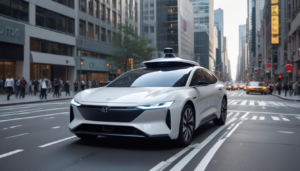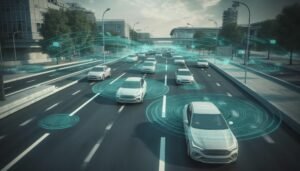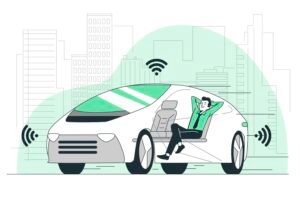Self-Driving Cars: Transforming the Roads of the Future
The rise of self-driving cars is one of the most revolutionary advancements in the world of transportation. Autonomous vehicles (AVs) have the potential to not only change how we commute but also reshape urban planning, reduce traffic accidents, and revolutionize logistics. While fully autonomous cars are not yet mainstream, significant progress has been made, and many experts believe that self-driving cars are closer to reality than ever before. In this blog, we’ll explore the latest developments in self-driving car technology, its potential benefits, and the challenges that still need to be overcome.
What Are Self-Driving Cars?
Self-driving cars, also known as autonomous vehicles, are vehicles equipped with sensors, cameras, and artificial intelligence (AI) systems that allow them to navigate roads without human intervention. These vehicles use a combination of technologies, including radar, lidar, and machine learning, to process data from their surroundings and make decisions in real-time. While the concept of these things has been around for decades, recent advancements in AI and machine learning have brought them closer to becoming a reality.
The Latest Developments in Self-Driving Car Technology
In 2025, the self-driving car industry has made significant strides in both technology and regulation. Major automotive companies, including Tesla, Waymo, and Cruise, have made notable advancements in their autonomous driving systems. Here are some of the key developments:
1. Improved AI and Machine Learning Algorithms

The success of self-driving cars depends heavily on their ability to make real-time decisions based on complex data inputs. Recent developments in AI and machine learning have made this process more efficient and accurate. Autonomous vehicles are now better equipped to handle unpredictable traffic situations, recognize pedestrians, and navigate through congested urban environments.
Advancements in AI have also improved the safety features of autonomous vehicles. For instance, new AI algorithms can analyze road conditions and adapt driving behavior accordingly, reducing the risk of accidents caused by poor weather or unpredictable traffic patterns.
2. Enhanced Sensor Technology

Sensors play a crucial role in enabling self-driving cars to perceive their surroundings. In recent years, sensor technology has seen remarkable advancements, allowing autonomous vehicles to detect objects at greater distances and with higher accuracy. Lidar (Light Detection and Ranging) and radar systems are now more precise, enabling cars to better detect obstacles, road signs, and pedestrians.
These enhanced sensors also contribute to a smoother driving experience, as they allow the car to anticipate potential hazards and take proactive measures to avoid them. This technology has moved self-driving cars closer to full autonomy by increasing their reliability and safety.
3. Regulatory Progress

While technology is advancing rapidly, regulation has lagged behind. However, in 2025, significant progress has been made in creating a legal framework for self-driving cars. Governments and policymakers are now working on establishing safety standards, liability rules, and insurance policies that will allow them to operate legally on public roads.
The development of regulatory frameworks is essential for the widespread adoption of autonomous vehicles. As regulations evolve, more companies will feel confident investing in the technology, leading to greater innovation and broader implementation.
The Benefits
Self-driving cars offer several potential benefits that could dramatically improve the way we travel and conduct business. Some of the key benefits include:
1. Increased Safety

One of the primary advantages of autonomous vehicles is their potential to reduce traffic accidents. According to the World Health Organization (WHO), over 1.35 million people die in road accidents each year, with human error being the leading cause. They can significantly reduce these numbers by eliminating driver errors caused by distractions, fatigue, or impaired judgment.
2. Improved Traffic Flow and Reduced Congestion

Self-driving cars are capable of communicating with each other and with traffic infrastructure, allowing for smoother traffic flow. Autonomous vehicles can adjust their speed and route in real-time to avoid congested areas, reducing the overall traffic burden. This could lead to shorter commute times and fewer traffic jams in major cities.
3. Increased Mobility for Disabled and Elderly Individuals

For individuals with disabilities or elderly people who are unable to drive, self-driving cars could offer newfound independence. Autonomous vehicles provide a means of transportation for people who would otherwise rely on public transportation or caregivers. This could greatly enhance their quality of life and give them more freedom to travel independently.
Challenges Facing Self-Driving Cars
Despite the exciting developments, several challenges remain before self-driving cars become a mainstream mode of transportation.
1. Technological Limitations

While significant progress has been made, self-driving cars are still not perfect. The technology needs to be refined to handle more complex road scenarios, such as unpredictable human behavior or adverse weather conditions like snow or heavy rain. Until these limitations are addressed, fully autonomous driving will remain a challenge.
2. Public Trust and Adoption

Many people are still skeptical about the safety and reliability of autonomous vehicles. To gain widespread public acceptance, self-driving car companies must not only demonstrate the safety of their technology but also ensure transparency in how their systems work.
Conclusion
With advancements in AI, sensor technology, and regulatory frameworks, we are getting closer to a future where autonomous vehicles become a common sight on the roads. However, challenges still remain, and the industry must continue to innovate and build trust with the public.
As we move forward, self-driving cars will not only improve road safety but also change how we commute, transport goods, and design our cities. The future of transportation is undoubtedly autonomous, and the possibilities are endless.
For more information on self-driving car technology, visit this comprehensive guide on autonomous vehicles.

